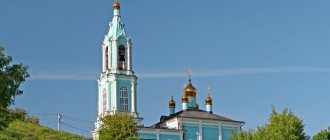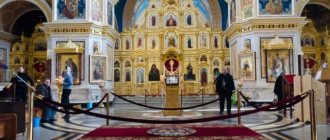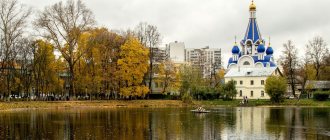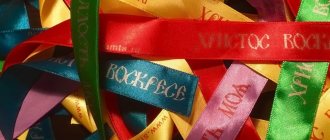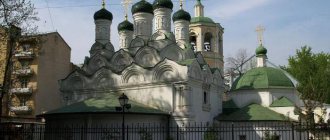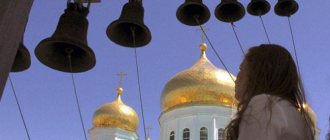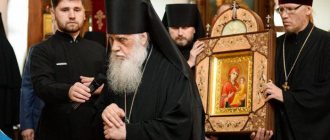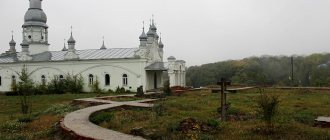Churches of the Nativity of the Blessed Virgin Mary
Church of the Nativity of the Virgin Mary in Putinki
The Church of the Nativity of the Virgin Mary in Putinki stands at the very beginning of Malaya Dmitrovka. Magnificent, as if made of snow-white lace, it was built in 1649-1652 - one of the most beautiful and ancient churches consecrated in honor of this holiday, preserved in Moscow. In ancient times, the Putinki tract was located here: here, at the Tverskaya Gate of the White City, two paths diverged - to the cities of Dmitrov and Tver. Here was then the Route Yard for ambassadors and messengers, to which paths led - crooked Moscow-style streets and alleys. Another version explains the name Putinki from the word “web” - small streets and alleys with small Moscow houses scattered on them, lying in the parish of this church, represented a “web” that surrounded the church on all sides.
Originally, there was a three-roofed wooden church built here in 1625. In 1648, it burned down, and the parishioners of the temple, through the Patriarch of Jerusalem, who was staying in Moscow at that time, asked the tsar to allocate money for the construction of a stone church. For the first time in Rus', its chapel was consecrated in honor of the icon of the Mother of God of the Burning Bush, which protects from fires and is therefore so significant for Muscovites. This church is the last building of hipped-roof architecture in Moscow before the famous decree of Patriarch Nikon. Then he banned the construction of tented churches and demanded a widespread transition to the construction of cross-domed churches. This decree would be canceled in the second half of the 17th century after the expulsion of Nikon.
In the same 17th century in Moscow, behind Zemlyanoy Gorod, near Zubovskaya Square, a church was erected with a main altar, consecrated in honor of the icon of the Burning Bush, which gave the name to the lane - Neopalimovsky. The name of the icon comes from Moses’ vision of a burning thorn bush - a bush - engulfed in flames and not burned, symbolizing the ever-virginity of the Most Holy Theotokos. Therefore, the Mother of God is depicted on the icon surrounded by flames.
And although, according to legend, the construction of this church was not connected with the main disaster of the old wooden city - numerous Moscow fires, they prayed at the miraculous icon and sought salvation precisely from the fire that more than once raged in Moscow and left the townspeople as fire victims.
And that's the legend. The list of the Burning Bush icon was in the Kremlin Chamber of Facets. Tsar Fyodor Alekseevich's groom Dmitry Koloshin prayed earnestly in front of her, and when he innocently fell into disgrace with the tsar, he began to ask for help and protection. Then the Queen of Heaven appeared to the king in a dream and revealed to him that this man was innocent. The groom was released from trial by the sovereign and, in gratitude, built a temple in honor of the Burning Bush icon in Novaya Konyushennaya Sloboda, begging the king for a miraculous list. Since then, when there were fires in Moscow, this icon was carried around the houses of church parishioners, and they survived the fire. Muscovites even noticed that in the Neopalimovsky parish fires occurred extremely rarely and were very insignificant, although the entire area remote from the city center was built up with numerous wooden houses. (Neopalimovskaya Church was demolished during Soviet times.)
The little-known, but remarkable for its history, house church of the Nativity of the Virgin Mary in the house of Prince Golitsyn (Volkhonka, 14, behind the building of the Museum of Private Collections) is now destroyed and does not function.
This temple entered the history of Moscow mainly because Pushkin was going to marry Natalya Goncharova here, but was refused by Metropolitan Philaret. Why this happened still remains a mystery to historians. Only the wedding then took place in the parish church of the bride, in the Great Ascension at the Nikitsky Gate.
The Nativity Church itself was a house church and was located on the second floor in the right wing of the existing building. It was directly related to the history of this house and the homeowners, as well as the events that took place here.
The history of the Golitsyn house dates back to the 30s of the 18th century, when they acquired a plot of land behind the Kolymazhny yard for ownership. The project of the house was executed by the St. Petersburg architect S. Chevakinsky, the author of the famous St. Nicholas Naval Cathedral in the northern capital, from whom Vasily Bazhenov studied. In the work on the construction of the Golitsyn house in 1756-1761. he was helped by the young architect I.P. Zherebtsov, the future builder of the beautiful bell tower of the Moscow Novospassky Monastery. In 1766, a church in the name of the Nativity of the Virgin Mary was built and consecrated in the right wing of the house. And soon Catherine the Great herself settled in the house.
The Golitsyn house was passed down from generation to generation. When M.M. Golitsyn-son became the owner, Catherine II turned to him with a request to find her a good and comfortable house in Moscow. The Kuchuk-Kainardzhi peace in the Russian-Turkish war had just been concluded, and the empress was going to Moscow for festivities on this occasion. She did not like to stay in the Kremlin, considering it poorly suited for her. Golitsyn immediately offered the empress his own house.
And then the architect Matvey Kazakov was invited to rebuild the Golitsyn mansion into the Prechistensky Palace. The construction was ready for the New Year, in December 1774. The walls of the modest estate remember the brilliant retinue of Catherine the Great - the empress came to Moscow with her court and son Paul I.
However, she was dissatisfied with the housing: it was cramped and the stoves did not heat the room well. The proximity to the Kolymazhny yard and the stables did not create the freshest air, people froze mercilessly, and the corridors were very confusing. “Two hours passed before I found out the way to my office,” Catherine complained in one of her letters, calling her palace “a triumph of confusion.” Then the wooden buildings of this palace were moved to Vorobyovy Gory and burned there.
According to legend, two icons were kept in the Nativity Church of the Golitsyn house, donated (or left here) by Catherine II in memory of her marriage to Prince Potemkin, apparently wedding icons. It is likely that this legend remained in Moscow’s memory associated with Catherine’s own stay in the Golitsyn palace. Or they thought that she left the owners a royal gift for their hospitality.
In 1779, the Golitsyns returned to their mansion on Volkhonka. When S.M. Golitsyn, trustee of the Moscow educational district, became the owner, he opened an aristocratic salon here. Pushkin visited it and once in the early summer of 1830 he danced here at a ball. Pushkin at that time was already engaged to Natalya Goncharova, and there is evidence that he was going to marry her here. Firstly, historians say, in the house church the payment was less, which was beneficial for Pushkin, who was strapped for funds. Secondly, the attention of high society to the wedding would not be so close.
And yet, permission to marry in the Golitsyn home church was not given. There is a version that it was simply forbidden for people who had nothing to do with them, “from the street,” to get married in house churches, as in ordinary parish churches. And the wedding took place in the bride's parish church.
In the second half of the 19th century, another S.M. lived here. Golitsyn, owner of an art gallery, an ancient library and a collection of antiquities. All this was collected by his father, who dreamed of opening his own museum, but did not have time to fulfill his desire before his death.
In memory of his father, on the first floor of his mansion in 1865, Golitsyn opened a museum, which was called the “Moscow Hermitage”. Here were presented such rarities as ivory vases that belonged to Marie Antoinette, books from the library of the Marquise of Pompadour, paintings by Raphael, Rubens, Poussin, and marble candelabra from Pompeii. And visitors were greeted by a doorman in the uniform of a life hussar.
The museum was open to the public, but curious evidence of how the inspection took place has been preserved. At the owner’s request, only those who came to Sunday services at his home Nativity Church could admire his collection. At the end, everyone went to the princely dining room for Sunday tea, which was attended by the owner, and from there to the museum.
However, just twenty years after the opening of the museum, Golitsyn, who had lost interest in its maintenance, sold his collection at auction. Most of it was bought by the St. Petersburg Hermitage for 800 thousand rubles. It is noteworthy that all the treasures of the Golitsyn Museum remained in their homeland.
In 1877, Golitsyn rented out the first floor of his house for apartments. The museum halls were rebuilt into furnished rooms for rent, and after the reconstruction of the left wing in 1892, they received the name “Princely Court”. A comfortable Moscow hotel has opened in the Golitsyn mansion.
In October 1877, A.N. settled in this house. Ostrovsky, who spent the last years of his life here. When the writer was drawing up a rental agreement, the caretaker of the house seriously began to explain to his wife that before renting out an apartment, he always collects certificates about the moral qualities of the future tenant. Ostrovsky jokingly decided to tell him “some of my virtues - that I am not a drunkard, not a brawler, and will not start a gambling or dance class in my apartment.”
In this house, “Dowry,” “Talents and Admirers,” and “Heart is not a Stone” came from Ostrovsky’s pen. Friends often came to visit him - I.S. Turgenev, D.V. Grigorovich, P.I. Chaikovsky. M.I. lived in the same house on Volkhonka. Tchaikovsky, V.I. Surikov, B.N. Chicherin, I.S. Aksakov, who died here.
In 1902, the Nativity Church was renovated. One of the best Moscow architects of that time, K.M. Bykovsky decorated it in the Gothic style, and the iconostasis in the semi-classical style.
This year became the last year in the history of the Nativity Church being the Golitsyns' home church. The following year, 1903, the house was purchased by the Moscow Art Society and then began to belong to various institutions. It is enough to mention the Moscow City People's University named after. A.L. Shanyavsky, who worked here in 1909-1911. before moving to our own building on Miusskaya Square.
In Soviet times, the former Golitsyn estate was occupied by the Communist Academy under the leadership of historian M.N. Pokrovsky. Then the Nativity Church was closed, and its iconostasis was dismantled and transferred to the church in the village of Alekseevskoye.
Currently, there is a scientific institution here - the Institute of Philosophy of the Academy of Sciences.
Moscow Nativity Convent. Church of St. John Chrysostom. Photo 1882
In Moscow there is also the Nativity Monastery, which was founded in 1386 by Princess Maria Keistutovna, the mother of the hero of the Battle of Kulikovo, Prince Vladimir Serpukhovsky. The magnificent Cathedral of the Nativity of the Blessed Virgin Mary was built in 1501-1505 - it is one of the oldest churches in Moscow. The slender bell tower was erected in 1835 by the architect N.I. Kozlovsky - one wealthy Muscovite donated her funds to it in memory of her beloved son who died early.
In this monastery in 1525, Solomonia Saburova, the wife of Grand Duke Vasily III, was forcibly tonsured a nun. They lived for 20 years, but their marriage turned out to be childless, and the prince wanted to have an heir to the throne. He decided to marry again - divorce was prohibited then, and Solomonia was persuaded to voluntarily enter a monastery, but she resisted. Then she was tonsured by force at the Nativity Monastery. According to an old Moscow legend, this was preceded by Grand Duke Vasily’s vision of a bird’s nest in a tree, when he burst into tears about his childlessness. “Sovereign! - the boyars told him: “The barren fig tree is cut and removed from the grapes.” When he turned to the Greek patriarchs for a blessing for divorce, the primate of Jerusalem, Mark, warned him: “If you marry a second time, you will have an evil child: your kingdom will be filled with horror and sadness, blood will flow like a river, the heads of nobles will fall, the cities will burn.” The Russians decided to do without the help of foreigners and invited Solomonia to voluntarily take monastic vows into a monastery. When she refused, she was forcibly tonsured. Then, according to legend, she cursed the future marriage of the Grand Duke and predicted: “God sees and will take revenge on my persecutor!” From the new marriage of Vasily III and Elena Glinskaya, the future Tsar Ivan the Terrible was born. According to legend, at the minute of his birth, August 25, 1530, at 7 pm, three peals of thunder followed one after another with a blinding flash of lightning.
Solomonia, tonsured under the name of Sophia, remained a nun for more than 17 years and died in 1542. There is a terrible legend that the supposedly newly tonsured wife of the Grand Duke turned out to be pregnant by him “to the horror and repentance” of her ex-husband. She gave birth to a son, named him George and raised him with a dream of revenge: “In due time he will appear in power and glory.” All the legends about the famous robber Kudeyar are associated with his name, who either led the Crimean Khan to Moscow during the reign of Ivan the Terrible, or, on the contrary, allegedly saved the life of his royal brother.
This monastery was not plundered during the Napoleonic invasion, although the French entered it. According to legend, they wanted to tear off the rich frame from the miraculous Kazan Icon of the Mother of God. One of the soldiers rushed to the image, but was immediately seriously injured and could no longer budge. Amazed by this, the rest of the invaders ran out of the monastery.
Corner of a brick monastery wall on the boulevard by artist V.G. Perov portrayed in the film “Troika”.
Shrines[edit]
The miraculous Tikhvin Icon of the Blessed Virgin Mary
- The miraculous Tikhvin Icon of the Blessed Virgin Mary
- Piece of the robe of the Blessed Virgin Mary
- The relics of St. Alexander Peresvet and Andrey Oslyabi (under cover).
- Icon of St. Alexander Peresvet and Andrey Oslyabi with a particle of the relics of Alexander Peresvet.
- Miraculous icon of St. Sergius of Radonezh
- Icon of St. Kirill Belozersky, St. Sergius of Radonezh, St. Theodore of Rostov
- Icon of St. Seraphim of Sarov
- Icon of St. Fyodor Simonovsky
- Icon of Demetrius of Thessalonica
- Icon of Patriarch Tikhon with a particle of relics
- Icon of Matrona of Moscow with a particle of relics
Patronal holidays[edit]
Nativity of the Blessed Virgin Mary
- September 21
Kirill Belozersky - June 22 (death day)
Nicholas the Wonderworker, Archbishop of Myra, Saint
— May 22, December 19
Sergius of Radonezh, Venerable
— Cathedral of Moscow Saints, July 18, October 8

